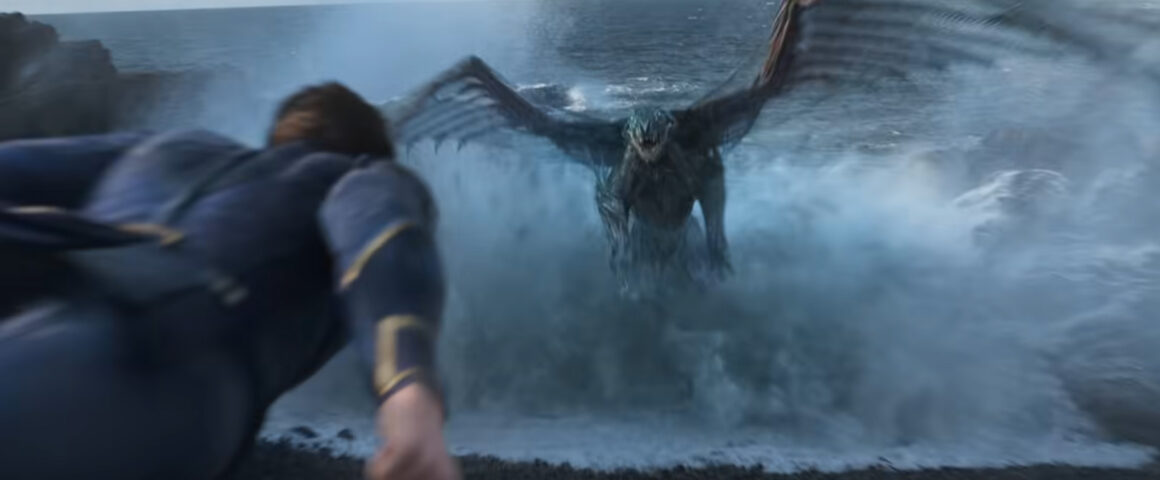Two beautiful people in a beautiful setting confess the beauty they see in each other, before creating something beautiful between them. There’s a lot of beauty in this scene, a scene that could happen in any number of films, but here it takes place in an entry in the Marvel Cinematic Universe (MCU). Its presence in this franchise makes it unusual. Despite the gorgeousness of its many performers, the intensity of its stories and the dazzle of its spectacle, the MCU has been largely chaste (aside from a brief tryst in 2008’s “Iron Man” and an abortive one in “The Incredible Hulk” from the same year). In Eternals, however, we see people having sex, in a suitably PG-13 way. The moment is not salacious or lurid, but tender and loving, suggesting a genuine and touching connection.
Connection and compassion are key to Eternals, and key to its status as a Chloé Zhao film. Over her (to date) brief filmography, Zhao has constructed films concerned with human connection, culminating in her Oscar-winning masterpiece “Nomadland.” Despite the blockbuster scale of Eternals, these same concerns run through Zhao’s latest. The titular long-lived beings, consisting of Sersi (Gemma Chan, “Mary Queen of Scots”), Ikaris (Richard Madden, “Rocketman”), Thena (Angelina Jolie, “Maleficent”), Ajax (Salma Hayek, “Beatriz at Dinner”), Kingo (Kumail Nanjiani, “The Big Sick”), Sprite (Lia McHugh, “The Lodge”), Phastos (Brian Tyree Henry, “Godzilla vs. Kong”), Makkari (Lauren Ridloff, “Sound of Metal”), Druig (Barry Keoghan, “The Killing of a Sacred Deer”) and Gilgamesh (Ma Dong-seok, “Train to Busan”), placed on Earth to protect humans against the specific threat of the monstrous Deviants, are a compassionate and even loving team, with a gentler banter than the Avengers and without the mercenary humor of the Guardians of the Galaxy. The feeling between these characters is exemplified by Ajax, a parental figure whose love extends from her “children” to encompass the people of Earth, and manifests in her superpower of healing. The Eternals’ encounters with humans over the centuries leads to a particular joy as various periods of history are brought to life. From Ancient Babylon to the Golden Age of India to 21st century London, production designer Eve Stewart creates these spots which are then presented in Zhao’s trademark compositions, lovingly rendered by cinematographer Ben Davis who also lensed “Captain Marvel” as well as “Three Billboards Outside Ebbing, Missouri.”
It may seem odd to wax lyrical about the visual beauty of a superhero film, but seeing the Eternals in these environments is key to the viewer’s engagement with the film. While Sprite charms Aztecs with elaborate displays reminiscent of movies, Druig argues that the Eternals should prevent the Spanish conquest of South America, despite the embargo on interfering in humanity’s development. The later dropping of the atomic bomb on Hiroshima leads to a profound loss of faith, after which the Eternals slip into “normal life,” awaiting their next calling. When it comes, its source is unexpected and prompts major tensions between loyalty and compassion.
The visual compositions that balance sky with earth and water, as well as the depths of space, the flaming fury of the sun and the imposing mass of the Eternals’ Celestial master Arishem (voiced by David Kaye, “Ratchet & Clank”), mirror the balance that the characters embody and that the film as a whole explores. When you have believed in something your whole (eternal) life, what does it mean to question that? This questioning leads to lively debates and plenty of humor in the film, including some brand flaunting that demonstrates Marvel’s absolute confidence over its place in contemporary culture. Nonetheless, there is a largely introspective tone that is sometimes offset by the action set pieces expected of the franchise, as the various but never overwhelming powers of the Eternals are used against the ferocious Deviants. Eye beams, illusions, mind control, superspeed, weapons conjured from nowhere and all manner of tools allow for plenty of spectacle. Best of all is the sudden transmutation of matter, which are both thrilling and gorgeous to behold. However, the Deviants seem more of a distraction from the main story of the tensions between the Eternals themselves, creating an odd disjunct within the film.
Indeed, there is a larger disjunct between Eternals and the rest of the MCU. References to the Avengers and Thanos feel more forced than organic, as do setups for future installments. Furthermore, with ten central characters the individual arcs are somewhat compressed, like multiple ideas in a long paragraph. There is some wonderful diversity, including a multiracial cast, a same-sex relationship and a deaf character played by a deaf actor, as well as one character who is a Bollywood movie star! Pleasing though this is, it does leave the viewer wanting more, either in a standalone film that did not need to tie into wider narratives, or in a long form format. In the context of Marvel Studios series such as “WandaVision,” “Loki” and “Hawkeye,” there is the question as to whether Eternals might have worked better as a series. However, the decision to stage this story as a movie demonstrates Marvel’s further disruption of how cinema narratives are understood. Borrowing much from comic book and television approaches, Eternals does much that is familiar but also provides new developments. The narrative may not carry quite the same balance as the visuals, but this very imbalance may prove a significant step forward in cinematic storytelling.



